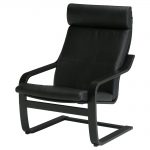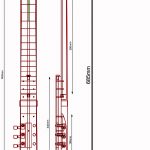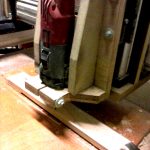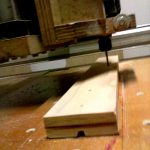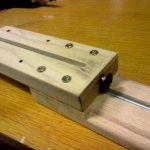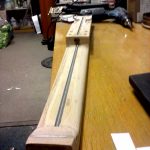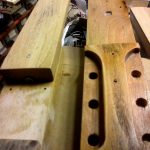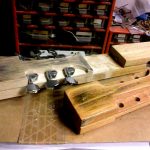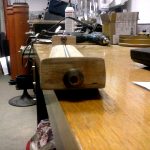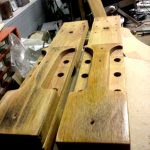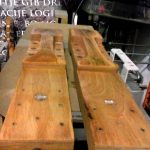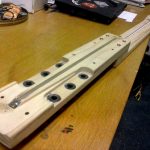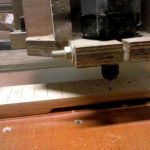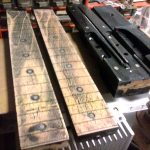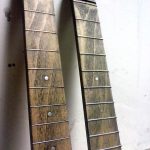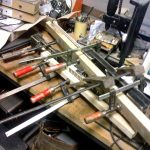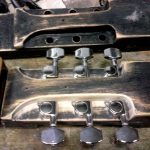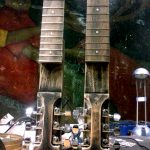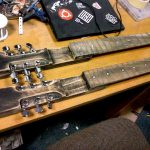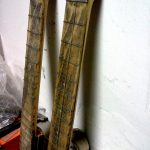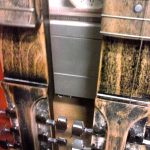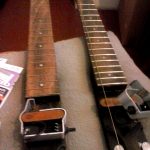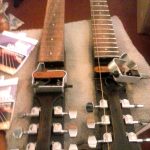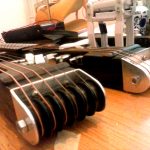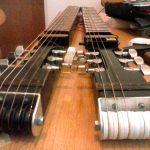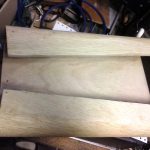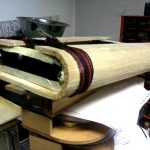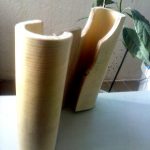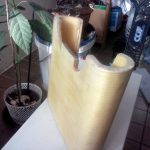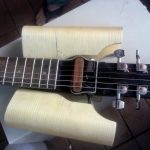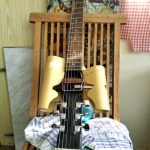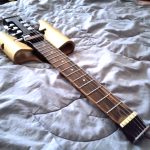Travel guitar is usually a short version of regular length guitar. In this case the strings are folded at the bottom and machine head is at the back. It is an electric guitar with a relatively wide fretboard (for my thick fingers) – basically a copy of the acoustic guitar that i have.
The final motive is simplicity and precision. Again the Cirkulacija 2 space proved invaluable for this project! CNC2 router was used throughout.
The idea came after a plan to have a performance of a project Herman & Savski in 2018 in Berlin – where one travels with a plane. Immediately a piece of material came to mind – the old rocking chair of my late mother (so-called POÄNG armchair). It was made of layered beech wood, bent everywhere and it seemed in good condition, so decision was made. Also: there were left and right sides – so: two identical guitars. Furthermore: idea of almost the mother’s bone used for a music instrument is quite archetypal!
Quite soon I became acquainted and said goodbye to quite a few puristic/ esoteric approaches about the sound of the material (of the electric guitar). The magnets to be used are two Coxx single core pieces that i have for some time. Piezo bridge pickup will be added later – to have an option to select a more acoustic sound.
Other decisions:
– there is no need for separate fretboard, since the beech wood is so hard
– i decided for a slight curvature of the fretboard (16inch)
– truss rod has to be there, since the layered material is so elastic
– truss rod was put from behind the neck
– another truss rod was put to counter the tension on the lower (bridge) side of the guitar
– these rods are simple 6mm threaded rods – fixed at one side to the wood
I ordered some 25cm pieces of fret wire. It came out to be so-called “jumbo” thickness. Not ok, but ok. Distances for correct intonation were calculated here
http://www.liutaiomottola.com/formulae/fret.htm#mozTocId169477
and put into CAM and cur by CNC2. The site http://www.liutaiomottola.com has a lot of useful information.
The varnishing of the wood was the least puristic. I used thin transparent (no color) varnish for mechanical protection of the surface. A couple of times. The result was a bit folkish. We don’t want that. So I used thick ebony varnish, which at the moment does not seem to have been a very good idea. So, I scrapped the black and got to some nicer wood patterns on the fretboard. By smearing it with a cotton bud dipped in thinner i got quite rustic finish. Ok.
By miscalculation I ordered so-called jumbo fret wire – and not enough of it. So I ordered some more from another source. This time it was very thin fret wire. Well, one neck now has thin low frets, the other has thick and high jumbo frets. I will see the difference soon enough.
I then glued the neck and the bridge/ body – I couldn’t wait. The fretboard/ fingerboard is ok, the back needs still some sanding – as do the other parts. The machine head was also mounted – I know I will have to unscrew it – but now i need to see the whole.
For the strings coming from the back bottom, then around the bottom and to the bridge – I bought a PE (plastic) round rod of 40mm diameter . It is a low friction turn-around for the strings coming to the front side. I cut the length (67mm), then cut it in half – along the length. I will make channels for the six strings that will bring them to the right spacing for the bridge saddle.
The first string was strung…
One conceptual mistake: the PE provides low friction only for non-wound strings. The tension is not transferred equally for lower strings. I almost ruined the machines’ teeth. At least for the four wound strings i would need to provide wheeled transmission of string tension. I decided to have all six strings via wheeled transmission. Also: i had to turn the machines so that the tension of the strings pushes the spiral transmission system towards the teeth – not away from the teeth.This was the reason for almost ruining the teeth.
Otherwise all is well. The two guitars are not identical anymore: one has a zero fret, the other has a bone nut. The two magnet pickups are fixed/ glued. The holder for electronics, battery, output jack and balance potentiometer (the set the measure of magnetic and optional piezo pickups – in the output signal) – is a piece of aluminium in a form of functional spiral.
A resonator (a piece of special lightweight one-direction foldable wood) is there to amplify the acoustics. It was planned before but added in 2019. Furthermore – it helps with handling the guitar. The overall design now looks very good – a bit of asymmetry.
The next step is a bit different solution at the bottom: especially the thin strings tend to be a bit short – and also – visually: a bit less (mass & mechanics) is needed there…
more to follow…
Below are some notes copied from various sources on the net
SCALE LENGTH
guitar string length nut to bridge
Fender Duosonic = 22.5 inch (571,5mm)
Gibson Byrdland = 23.5 inch (596,9mm)
Fender Jag-Stang = 24.0 inch (609,6mm)
*mine acoustic = 24,53 inch (623mm)
Gretsch 6120/Duojet/Setzer = 24.6 inch (624,84mm)
Gibson LesPaul/SG = 24.75 inch (628,65mm)
Rickenbacker 330/360 = 24.75 inch (628,65mm)
Martin 000 = 24.9 inch (632,46mm)
NECK THICKNESS
there are three basic groupings in terms of thicknesses:
Super Thin: any neck with a 17-19mm thickness at the nut
Moderately Thin: any neck with a 20-22mm thickness at the nut
Meaty: any neck with a 23mm+ thickness at the nut
One last comment about neck profile: I prefer a “C” shape because it feels continuous and predictable, whereas a “D” shape has a noticeable flattening out that I can detect with my thumb.
modern oval flat (flattened at the bottom: D shape)
oval C shape (half sphere)
*mine = 20mm w/o back cover for truss rod – 21mm with it
BRIDGE
Guitar “E” to “e” String Spacing at Bridge (Narrow to Wide)
Rickenbacker = 1.98 inches (50.29mm)
Gibson Tuno-O-Matic = 2.0625 inches (52.45mm)
Fender Import Strat = 2.0625 inches (52.45mm)
Floyd Rose = 2.070 inches (52.58mm)
*mine acoustic = 2.1 inches (53.00mm)
Fender Jaguar / Jazzmaster / Mustang = 2.1875 inches (55.56mm)
Fender USA Strat = 2.21875 inches (56.35625mm)
NUT
Guitar “E” to “e” String Spacing at Nut (Narrow to Wide)
*mine acoustic = 1.555 inch (39.5mm)
FRETBOARD RADIUS
Most guitars have a single radius that is consistent across the length of the fretboard. On the small end of the spectrum, we have something like a 7.25” radius, which can be found on some vintage Fender instruments. On the large end of the spectrum, we have something like a 30” radius, which can be found on some classical guitars that aim to be nearly flat, but have a very slight curvature. Halo fretboards are typically in the range of 16” to 20”. We use a smaller radius on our relatively narrower necks and a larger radius on our relatively wider necks. For example, our 6-string guitars typically have a 16” radius
no radius -vintage classic
16 inch – modern electric/ classic + acoustic
12 inch – recent electric
9 inch – sixties – electric
*mine acoustic = 16 inch (406,40mm)
FRET POSITIONS
623.000mm fret scale
fret from nut fret to fret
1 34.966mm 34.966mm (nut-1)
2 67.970mm 33.004mm (1-2)
3 99.122mm 31.151mm (2-3)
4 128.525mm 29.403mm (3-4)
5 156.277mm 27.753mm (4-5)
6 182.472mm 26.195mm (5-6)
7 207.197mm 24.725mm (6-7)
8 230.535mm 23.337mm (7-8)
9 252.562mm 22.027mm (8-9)
10 273.353mm 20.791mm (9-10)
11 292.977mm 19.624mm (10-11)
12* 311.500mm 18.523mm (11-12)
13 328.983mm 17.483mm (12-13)
14 345.485mm 16.502mm (13-14)
15 361.061mm 15.576mm (14-15)
16 375.762mm 14.702mm (15-16)
FRETS SIZE
The size of the actual fret wire installed in the fretboard makes a difference in feel. It is very subtle, but noticeable. Fret wire is available in a variety of different widths and heights. To simplify things, I’ll just say that there are three widths:
Narrow
Medium
Wide
And three heights:
Short
Medium
Tall
Narrow fret wire has two main benefits. The first is that it can provide better intonation over the lifetime of the instrument compared to wide fret wire. I would argue, though, that most people couldn’t hear the difference (I know I can’t) and some simple fret maintenance would make this a moot point.
 my RSS
my RSS
